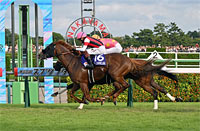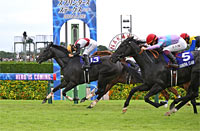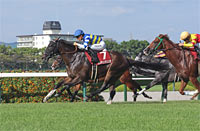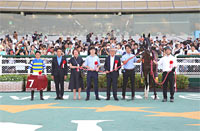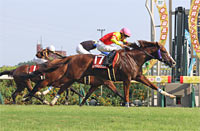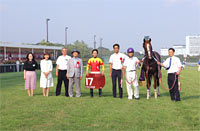Sprinters Stakes (G1) - Data Analysis
First G1 race of the autumn season decides the turf sprint champion
In 2020, race favorite Gran Alegria won the Sprinters Stakes, and received the JRA Award for Best Sprinter or Miler. Between 2011 and 2020, seven of the 10 runners selected for the JRA Award for Best Sprinter or Miler triumphed in the Sprinters Stakes of the same year. These included runners that secured their only G1 victory of the year in this race, such as Curren Chan in 2011, Snow Dragon in 2014, and Red Falx in 2017. To determine which runner is most likely to take the crown in this highly-anticipated battle that brings together the contenders for the title of sprint champion, let’s now analyze some features shared by successful runners in this race based on results over the last 10 years, including the race held at Niigata Racecourse in 2014.
Watch performance since the turn of the year
Of the 30 Top 3 finishers in the last 10 years, 24 had experience of winning “an open-class race held at one of the four major JRA racecourses (Tokyo, Nakayama, Kyoto, and Hanshin Racecourses) in the same year.” Conversely, runners without such experience struggled with a Top 3 ratio of 5.8%. We should therefore lower our expectations of runners that have not won an open-class race held at one of the four major JRA racecourses since the turn of the year. [Table 1]
[Table 1] Performance by experience of winning “an open-class race held at one of the four major JRA racecourses (Tokyo, Nakayama, Kyoto, and Hanshin Racecourses) in the same year” (last 10 years)
| Experience |
Performance
[1st-2nd-3rd-4th or lower] |
Win ratio |
Top 2 ratio |
Top 3 ratio |
| Yes |
10-8-6-32 |
17.9% |
32.1% |
42.9% |
| No |
0-2-4-98 |
0% |
1.9% |
5.8% |
In addition, five of the six Top 3 finishers without experience of winning “an open-class race held at one of the four major JRA racecourses (Tokyo, Nakayama, Kyoto, and Hanshin Racecourses) in the same year” had 16 or fewer careers starts and were fillies or mares. In other words, we should not necessarily lower our expectations of fillies and mares with shorter careers, even if they fail to clear the condition in the previous paragraph. [Table 2]
[Table 2] Among runners without experience of winning “an open-class race held at one of the four major JRA racecourses (Tokyo, Nakayama, Kyoto, and Hanshin Racecourses) in the same year,” performance by total career starts and gender (last 10 years)
| Total career starts and gender |
Performance
[1st-2nd-3rd-4th or lower] |
Win ratio |
Top 2 ratio |
Top 3 ratio |
16 or fewer career starts;
fillies and mares |
0-2-3-6 |
0% |
18.2% |
45.5% |
17 or more career starts or
colts and geldings |
0-0-1-92 |
0% |
0% |
1.1% |
Fillies and mares have a slight advantage
Looking at performances by runners in terms of gender, we find that colts and geldings achieved a Top 3 ratio of 15.0%, and fillies and mares a Top 3 ratio of 26.4%. There was no major difference in the number of Top 3 finishers, so we should mainly focus on fillies and mares. [Table 3]
[Table 3] Performance by gender (last 10 years)
| Gender |
Performance
[1st-2nd-3rd-4th or lower] |
Win ratio |
Top 2 ratio |
Top 3 ratio |
| Colts and geldings |
7-5-4-91 |
6.5% |
11.2% |
15.0% |
| Fillies and mares |
3-5-6-39 |
5.7% |
15.1% |
26.4% |
In addition, 12 of the 16 colts and geldings that finished in the Top 3 had experience of winning “a JRA graded race in the same year.” Conversely, colts and geldings without such experience struggled with a Top 3 ratio of 6.2%. In addition, if we limit our analysis to the last six years since 2015, the performance of runners in this group was [0-0-1-33] (Top 3 ratio of 2.9%). This suggests we need to discount colts and geldings that have not won a JRA graded race since the turn of the year. [Table 4]
[Table 4] Among colts and geldings, performance by experience of winning “a JRA graded race in the same year” (last 10 years)
| Experience |
Performance
[1st-2nd-3rd-4th or lower] |
Win ratio |
Top 2 ratio |
Top 3 ratio |
| Yes |
6-4-2-30 |
14.3% |
23.8% |
28.6% |
| No |
1-1-2-61 |
1.5% |
3.1% |
6.2% |
Strong performers last time out tend to fare well
Of the 30 Top 3 finishers in the last 10 years, 24 had finished either 1st or 2nd or lower with a time difference of 0.3s or less with the winner in their previous race. Conversely, runners that had finished 2nd or lower with a time difference of 0.4s or more with the winner in their previous race struggled with a Top 3 ratio of 8.5%. This trend was even more apparent if we limit our analysis to the five years since 2016, when the runners in this group delivered performance of [0-1-1-38] (Top 3 ratio of 5.0%). When comparing the lead-up races of this year’s runners, we should focus on runners that were strong performers last time out. [Table 5]
[Table 5] Performance by finish in previous race and time difference with winner in that race (last 10 years)
Finish in previous race and
time difference with winner in that race |
Performance
[1st-2nd-3rd-4th or lower] |
Win ratio |
Top 2 ratio |
Top 3 ratio |
1st, or 2nd or lower with time difference
with winner of 0.3s or less |
10-7-7-65 |
11.2% |
19.1% |
27.0% |
2nd or lower with time difference
with winner of 0.4s or more |
0-3-3-65 |
0% |
4.2% |
8.5% |
Poor showing by runners that had been positioned 2nd or higher when passing the 4th corner in their previous race
Of the 21 Top 3 finishers in the last seven years, 19 had contested a domestic race last time out (excluding straight-course races), and had been positioned “3rd or lower” when passing the 4th corner in that race. Conversely, runners that had been positioned “2nd or higher” when passing the 4th corner in their previous race struggled with a Top 3 ratio of 9.1%. In other words, we should not expect too much from front runner-type horses. [Table 6]
[Table 6] Among runners that had contested a domestic race last time out, performance by position when passing 4th corner in previous race (last seven years)
Position when passing 4th corner
in previous race |
Performance
[1st-2nd-3rd-4th or lower] |
Win ratio |
Top 2 ratio |
Top 3 ratio |
| 2nd or higher |
0-1-1-20 |
0% |
4.5% |
9.1% |
| 3rd or lower |
7-6-6-65 |
8.3% |
15.5% |
22.6% |
Note: Excluding runners that had contested their previous race on a straight course.
Career also a key factor
Of the 15 Top 3 finishers in the last five years, 14 had “26 or fewer” career starts. Conversely, runners with “27 or more” careers starts struggled with a Top 3 ratio of 3.7%. If trends in recent years are anything to go by, we should lower our expectations of runners with 27 or more careers starts. [Table 7]
[Table 7] Performance by total career starts (last five years)
| Total career starts |
Performance
[1st-2nd-3rd-4th or lower] |
Win ratio |
Top 2 ratio |
Top 3 ratio |
| 26 or fewer |
5-5-4-39 |
9.4% |
18.9% |
26.4% |
| 27 or more |
0-0-1-26 |
0% |
0% |
3.7% |
Seek out the winner!
Closing speed is a decisive factor
The last five winners had all been ranked 3rd or higher in their estimated time over the final three furlongs last time out. Our initial focus should therefore be on runners with impressive closing times in their previous race. Other shared features among the five winners were that (1) they had experience of winning “an open-class race held at one of the four major JRA racecourses (Tokyo, Nakayama, Kyoto, and Hanshin Racecourses) in the same year,” (2) they had finished either 1st or 2nd or lower with a time difference of 0.1s or less with the winner in their previous race, (3) they had been positioned 6th or lower when passing the 4th corner in their previous race, and (4) they had 26 or fewer career starts. This suggests we should also consider the trends in Table 1, Table 5, Table 6, and Table 7. [Table 8]
[Table 8] Winners’ ranking by estimated time over final three furlongs last time out, highest finish in “an open-class race held at one of the four major JRA racecourses (Tokyo, Nakayama, Kyoto, and Hanshin Racecourses) in the same year,” finish in previous race, time difference with winner in previous race, and position when passing 4th corner in previous race, total career starts (last five years)
| Year |
Winner |
Ranking by estimated time over final three furlongs last time out |
Highest finish in “open-class race held at one of the four major JRA racecourses” in same year |
Finish in previous race |
Time difference with winner in previous race |
Position when passing 4th corner in previous race |
Total career starts |
| 2016 |
Red Falx |
1st |
1st (Keyaki Stakes) |
1st |
- |
9th |
17 |
| 2017 |
Red Falx |
3rd |
1st (Keio Hai Spring Cup) |
3rd |
0.1s |
13th |
22 |
| 2018 |
Fine Needle |
3rd |
1st (Centaur Stakes, etc.) |
1st |
- |
6th |
26 |
| 2019 |
Tower of London |
1st |
1st (Centaur Stakes, etc.) |
1st |
- |
7th |
13 |
| 2020 |
Gran Alegria |
1st |
1st (Yasuda Kinen) |
1st |
- |
7th |
8 |
(Masaya Ibuki)
|















